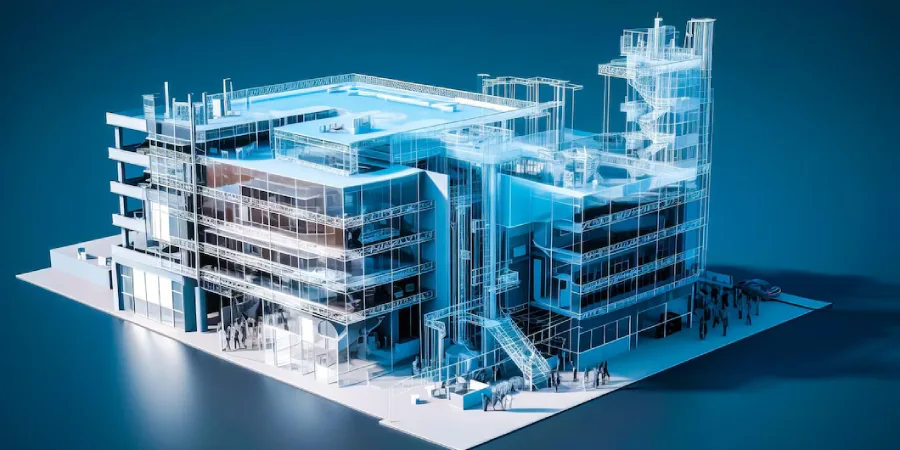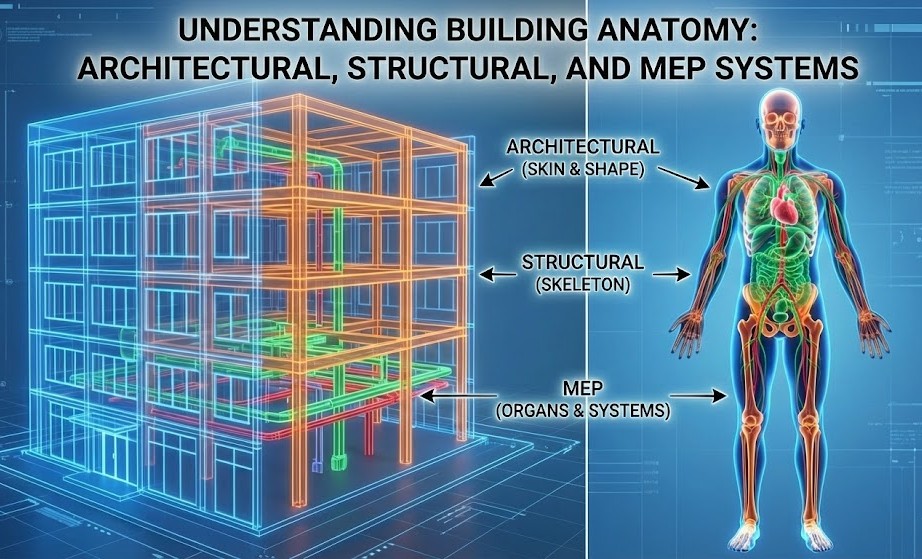
Author: Devika R
August 6, 2024
5 min read
Building Information Modeling (BIM) has revolutionized the way we design, construct, and manage buildings and infrastructure. This digital representation of a physical structure has found applications across various engineering streams, optimizing processes, enhancing collaboration, and delivering superior projects. Let us explore how BIM is transforming different engineering disciplines.
BIM in Civil Engineering

Civil engineers are leveraging BIM for:
- Infrastructure planning and design: Creating detailed 3D models of roads, bridges, tunnels, and other infrastructure components.
- Site analysis and terrain modeling: Analyzing site conditions, generating accurate topographic maps, and assessing potential impacts.
- Construction sequencing and planning: Visualizing construction phases, optimizing resource allocation, and identifying potential conflicts.
- Cost estimation and project management: Integrating cost data into BIM models for accurate budgeting and tracking project progress.
- Sustainability analysis: Assessing environmental impact, optimizing material usage, and exploring sustainable design options.
BIM in Structural Engineering

Structural engineers use BIM to:
- Structural analysis and design: Modeling structural elements, performing load calculations, and optimizing designs for efficiency.
- Reinforcement detailing: Creating accurate and detailed drawings for concrete reinforcement.
- Clash detection: Identifying conflicts between structural elements and other building components.
- Fabrication and erection planning: Generating fabrication drawings and assembly sequences for efficient construction.
BIM in Electrical Engineering

Electrical engineers benefit from BIM by:
- Electrical system design: Modeling electrical systems, including power distribution, lighting, and fire alarm systems.
- Coordination with other disciplines: Ensuring seamless integration of electrical systems with structural and architectural elements.
- Energy analysis: Assessing energy efficiency and identifying opportunities for optimization.
- Documentation and as-built modeling: Creating accurate electrical drawings and updating models to reflect the built environment.
BIM in Mechanical, Plumbing, and HVAC Engineering (MEP)

MEP engineers utilize BIM to:
- System design and modeling: Creating detailed 3D models of plumbing, heating, ventilation, and air conditioning systems.
- Coordination and clash detection: Identifying conflicts between MEP systems and other building components.
- Performance analysis: Simulating system performance and optimizing energy efficiency.
- Fabrication and installation planning: Generating fabrication drawings and installation sequences.
BIM in Architectural Engineering

Architectural engineers collaborate with other disciplines using BIM to:
- Building envelope design: Modeling building enclosures, including walls, roofs, and windows.
- Façade engineering: Designing and analyzing building facades for structural integrity and energy performance.
- Sustainability analysis: Assessing building performance in terms of energy consumption, water usage, and indoor environmental quality.
- Construction documentation: Creating detailed construction drawings and specifications.
Engineer Awareness and Adoption of BIM

While BIM’s potential is widely recognized, the level of awareness and adoption varies significantly across different engineering fields and regions.
High Awareness and Adoption:
- Architects and Structural Engineers: These professionals often lead BIM adoption due to the visual nature of their work and the early involvement in the design process.
- MEP Engineers: The complexity of MEP systems necessitates detailed modeling, driving BIM adoption in this field.
- Engineers in Developed Regions: Countries with mature construction industries, such as the UK, the US, and Scandinavian nations, have higher BIM penetration rates.
Moderate Awareness and Adoption:
- Civil Engineers: BIM adoption in civil engineering is growing, particularly for large-scale infrastructure projects.
- Engineers in Emerging Economies: While awareness is increasing, challenges regarding technology infrastructure, skill development, and industry standards hinder wider BIM adoption.
Low Awareness and Adoption:
- Engineers in Traditional Engineering Fields: Some engineers in specialized fields, such as geotechnical or environmental engineering, may have limited exposure to BIM.
Engineer Perspectives on BIM

Engineers’ perspectives on BIM vary based on their experience, the nature of their work, and organizational culture.
- Early Adopters: These engineers recognize BIM’s potential to improve efficiency, quality, and collaboration. They are often champions for BIM implementation within their organizations.
- Cautious Adopters: Some engineers know BIM’s benefits but are concerned about the learning curve, software costs, and potential workflow disruptions.
- Resistance to Change: A small percentage of engineers may resist BIM adoption due to a preference for traditional methods or a lack of understanding of its advantages.
Overcoming Challenges and Fostering BIM Adoption
To accelerate BIM adoption, the industry needs to address several challenges:
- Education and Training: Providing comprehensive BIM training programs for engineers at all levels.
- Industry Standards: Developing and implementing standardized BIM workflows and data formats.
- Software Integration: Ensuring seamless integration of BIM software with other engineering tools.
- Collaboration: Promoting effective collaboration among different engineering disciplines.
- Government Support: Implementing supportive policies and incentives for BIM adoption.
By overcoming these challenges and fostering a collaborative environment, the engineering industry can fully realize the benefits of BIM and drive innovation in the built environment.





